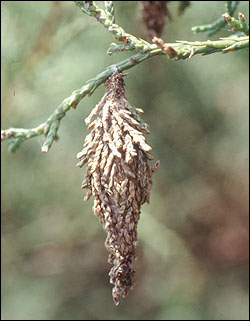The most important species of bagworm in the United States is Thyridopteryx ephemeraeformis (Haworth). This native moth is found extensively throughout the eastern and southern states and reportedly feeds on 128 plant species. The most commonly attacked host plants are arborvitae, red cedar and other juniper species, black locust, maple and sycamore.
The bagworm can be a constant threat to evergreen and deciduous shrubs used for landscaping. Attacked plants usually are partially defoliated, weakened and rendered unsightly. It is not uncommon for complete defoliation to occur.
Biology

The most noticeable or visible sign of a bagworm infestation is the presence of silken bags attached to a branch (Figure 1). The bag somewhat resembles a Christmas tree ornament hanging from a limb.
From late May to mid-June, bagworm larvae (caterpillars) begin emerging from the bags. Almost immediately after emerging, a larva starts to produce its own protective bag or case about its body. With its head and legs free, it is able to move about the plant as it feeds on the foliage. As the larva grows, it increases the size of its bag and incorporates into it bits of twigs and leaves for strength and camouflage protection.
A larva will spend its entire life within its bag, passing through four molts. The full-grown larvae are about 1 inch long. The head and thoracic regions of the body are yellowish and spotted with black, while the rest of the body is dark brown.
When a host plant becomes defoliated, the larvae will crawl off it with their bags and search for a new plant to feed on. When populations are high, this can lead to a "pedestrian" migration of thousands of larvae. Because of this behavior, i.e. colonizing new host plants by walking, bagworm infestations spread from one area to another relatively slowly. However, bagworms can also disperse as ballooning larvae and as eggs in cases floating in rivers and streams. In mid-August the mature larvae stop feeding and attach their bags, now close to 2 inches long, firmly to a twig. They close the open end of the bag and pupate within it.
By mid-September the bagworm has completed its development, and adult males begin emerging from their bags. The male moth has a black, furry body and a feathery antenna. The four wings are almost transparent and have a wingspan of about 1 inch. The males fly about infested plants seeking out females. After mating, the male moth dies.
The adult female bagworm does not look like a moth and never leaves her bag. She is about 0.75 inches long and lacks eyes, antennae, wings, legs or functional mouth parts. She is maggot-like in appearance, soft-bodied and yellowish-white. A mated female lays between 500 and 1,000 eggs within her bag, after which she dies. The eggs remain within the bag throughout the winter until they hatch the following spring. There is one generation each year.
Control
Some species of birds (e.g. sapsuckers and woodpeckers) are able to tear open the bags and feed on the larvae. The bagworm also is attacked by some insect predators and parasitoids that usually are effective in controlling small to moderate populations. However, these natural enemies seldom control large bagworm populations until after extensive damage has occurred.
The cheapest method of controlling bagworms on small trees and ornamentals is to hand-pick the bags. Be sure to pick off all bags and destroy them.
For larger plants where hand-picking is not practical, the bagworm can be controlled chemically. Apply the insecticide in the spring as soon as the eggs hatch and small larvae begin emerging from the overwintering bag. Spray applications are most effective if made during this time. Chemical control becomes less effective as the season progresses because of the increased size of the larva and its bag.
Some of the insecticides that can be used against the bagworm are shown in Table 1.
Table 1. Some insecticides labeled for bagworm.
| Insecticide | Trade name |
|---|---|
| acephate | Orthene Turf, Tree and Ornamental Spray |
| bifenthrin | Talstar 10 WP |
| Bt (Bacillus thuringiensis) | Dipel, Biobit, Javelin |
| carbaryl | Sevin |
| chlorpyrifos | Dursban 50W |
| diazinon | D.Z.N. 50W |
| lambda-cyhalothrin | Scimitar |
| malathion | Malathion |
| Note: Before using any chemical, please read the label carefully for directions on application procedures, appropriate rate, first aid, and storage and disposal. Make sure that the chemical is properly registered for the intended use. | |